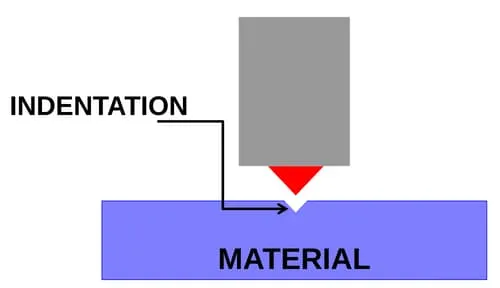Metal is subjected to indentation with a hard indenter. Depth of the indent is a measure of hardness.

Hardness units differ with the type of indenter used and the load applied.
Brinell (HB)
Section titled “Brinell (HB)”- diameter steel / WC ball indenter
- Any load can be applied
- Diameter of the indentation is measured instead of the depth
Here:
- - applied load (in )
- - diameter of the indenter (in )
- - diameter of the indentation (in )
- - depth of the indentation (in )
Vickers (HV)
Section titled “Vickers (HV)”- Pyramid shaped indenter made of diamond
- Any load can be applied
- Diagonal lengths and of the diamond-shape indentation are measured
- Average is used in the calculation
Rockwell (HR)
Section titled “Rockwell (HR)”Not accurate enough to be used in academic level (or where accuracy is important). Industrially preferred because of ease of measurement. Only 3 load options.
| Type | Load | Indenter |
|---|---|---|
| HRA | 60kg | Cone-shaped indenter. Made of diamond. |
| HRD | 100kg | Cone-shaped indenter. Made of diamond. |
| HRC | 150kg | Cone-shaped indenter. Made of diamond. |
| HRF | 60kg | 1/16” diameter (1.5mm approx.) ball made of steel |
| HRB | 100kg | 1/16” diameter (1.5mm approx.) ball made of steel |
| HRG | 150kg | 1/16” diameter (1.5mm approx.) ball made of steel |
| HRE | 100kg | 1/8” diameter (3mm approx.) ball |